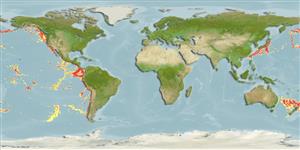Élasmobranches (requins et raies) (sharks and rays) >
Rajiformes (Skates and rays) >
Arhynchobatidae (Softnose skates)
Etymology: Bathyraja: Greek, bathys = deep + Latin, raja, -ae = a ray (Raja sp) (Ref. 45335); spinosissima: Name from Latin 'spinosus' meaning thorny, referring to the prickles on both the ventral and dorsal surface..
More on authors: Beebe & Tee-Van.
Environment: milieu / climate zone / depth range / distribution range
Écologie
marin bathydémersal; profondeur 800 - 2938 m (Ref. 50610). Deep-water
North Pacific: from the Bering Sea, south to the Galapagos Islands and Costa Rica.
Taille / Poids / Âge
Maturity: Lm ? range ? - ? cm
Max length : 200 cm TL mâle / non sexé; (Ref. 126515)
Description synthétique
Morphologie | Morphométrie
This large skates (200.3 cm TL), with large disc length and width (44.1-56.9 and 50.6-67.3% TL, respectively) are distinguished by the following: pectorals with rounded apices; head moderately long (14.0-20.5 % TL), interspiracular length large (9.1-12.2% TL), mouth width large (6.1-13.0% TL); teeth in 31-33 rows on upper jaw and in 24-31 rows on lower jaw; total vertebrae 137; dorsal and ventral surfaces are covered with prickles; thorns usually absent on dorsal surface, with tail thorns (22-28), interdorsal thorns weakly developed or absent (0-1), no middorsal, nuchal, and scapular thorns. Colouration: dorsal pale white to grey, while ventral is pale white; outer edges of pectorals dark (Ref. 126515).
Found in deep waters to almost 3,000 m, making it one of the deepest dwelling skates; prefer cold temperatures compared to its congeners. Feeds on deep-water benthic fishes. Size at maturity for males is unknown, for female specimens, size at maturity at 98 cm TL; with size at birth 25 cm TL. Egg cases are large compared to its congeners (9.2 cm TL); colour plum brown and longitudinally weakly striated, with both surfaces of the case plush-like to the touch. Horns with posterior ones curve inwards and with narrow at tips (Ref. 126515).
Life cycle and mating behavior
Maturité | Reproduction | Frai | Œufs | Fécondité | Larves
Oviparous, paired eggs are laid. Embryos feed solely on yolk (Ref. 50449). Eggs have horn-like projections on the shell (Ref. 205).
Knuckey, J.D.S. and D.A. Ebert, 2022. A taxonomic revision of Northeast Pacific softnose skates (Rajiformes: Arhynchobatidae: Bathyraja Ishiyama). Zootaxa 5142(1):1-89. (Ref. 126515)
Statut dans la liste rouge de l'IUCN (Ref. 130435)
Menace pour l'homme
Harmless
Utilisations par l'homme
Warning: mysqli::__construct(): (08004/1040): Too many connections in /var/www/html/includes/func_getlabel.php on line 46
Can't connect to MySQL database (fbapp). Errorcode: Too many connections
